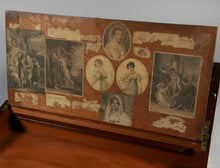Royal Navy Sailing Master's Writing Slope, 1811
- Regular price
- £2,800
- Sale price
- £2,800
- Regular price
-
- Unit price
- /per
Adding product to your cart
50.5cm (20in) x 26cm (10in) x 17cm (6.75in)
Provenance: Commander George Millard, R.N., (1792-1870)
Mahogany, brass and bone. A Regency brass bound naval officer’s writing slope, bearing the name plate of ‘Mr Millard / Master / R.N.’, fitted with recessed brass handles. The interior fitted with dividers, pen tray, and spring operated secret drawer, and further bone handled drawers, the underside of the lower slope decorated with engravings and fragments of manuscript letters.
In contrast with the grizzled Sailing Masters of naval fiction, George Millard was under twenty years old when he qualified by examination to receive the Navy Board’s warrant in 1811. Born in Blackfriars, London, his first posting was as Acting Mate of the 18-gun sloop H.M.S. Dasher before joining the 32-gun H.M.S. Sir Francis Drake which was built at Bombay for the East India Company and purchased by the Royal Navy in 1805. As Master of a fifth-rate frigate of some 250 souls, Millard would have been a considerable figure aboard ship. He would have been the best paid officer after the captain and would have had a large cabin in the gunroom, as well as a smaller day cabin next to the captain's cabin on the quarterdeck for charts and navigation equipment. His responsibilities were heavy and included navigating the ship, supervision of the midshipmen and mates in taking noon sightings of the sun, maintenance of the ship’s compass, upkeep of the official ship’s log, and pilotage. He was responsible for the ship’s anchors, the security and issue of beers and spirits and stowage of the ship, especially where this effected her trim and sailing qualities. Much of the above entailed providing himself ‘with such charts, nautical books and instruments as are necessary for astronomical observations and all other purposes of navigation’.
Read More
In terms of rank Millard was ‘with but after the lieutenants’ though his pay in a fifth-rate was equal to theirs. With no clear path to the becoming a Master his social status was ambiguous. He may have been at sea since boyhood in the merchant service or to have clawed his way up from the lower deck. He could also have been a volunteer and midshipman who despaired of a career without patronage. As the senior Warrant Officer he was granted privileges of the wardroom that in larger ships were extended to the Purser, Surgeon and Chaplain. To be posted aboard a fifth-rate ship such as the Sir Francis Drake, however, was considered an attractive appointment owing to her manoeuvrability, firepower and the chance of prizes.
In early 1811 the Drake was one of the naval units engaged in the Capture of Java, qualifying Millard, many years later, for the Java clasp to the Naval General Service Medal (1846). She sailed from India escorting troops and on 23 May 1811 was detached north-east of the port of Rembang when she attacked a flotilla of fourteen Dutch gun vessels off Surabaya, capturing nine of them. On 4 August the Drake joined Akbar, Phaëton and Bucephalus, in blockading the French frigates Nymphe and Méduse in Batavia road, during the landing of 8,000 troops. The city of Batavia capitulated on 8 August, with the French and Dutch defenders withdrawing to a previously prepared fortified position of Fort Cornelis, which fell on 26 August. The remaining defenders, a mixture of Dutch and French regulars and native militiamen were dealt with on 29 August 1811 in a successful amphibious operation carried out by the Sir Francis Drake, Phaëton and Millard’s old sloop Dasher with the ships' boats and marines of H.M.S. Hussar (46-guns), and captured the town and fort of Samanap in the face of a large Dutch defending force. The invasion of Java was completed with the surrender of Dutch and French forces in September 1811.
Millard thereafter served in Hussar, the sloop Slaney, and the Conway class post-ship Tamar at the war’s end in 1815. He remained in the Royal Navy serving successively serving as Master in Medway, Tees, Conqueror, Hyperion, Blanche, Canopus, and Royal Sovereign in 1837. With the end of the classic age of sail, wardroom warrant officers were given commissioned status in 1843. He retired in 1846 with rank of Commander and resided latterly at Warwick Square, Peckham Rye on the outskirts of London.








